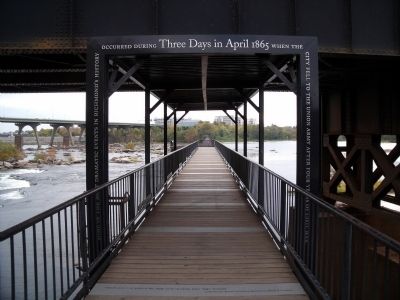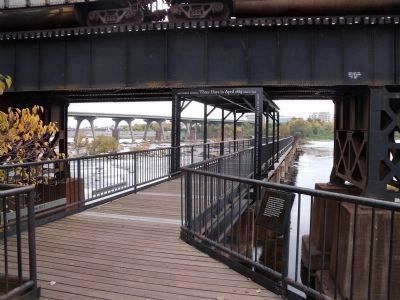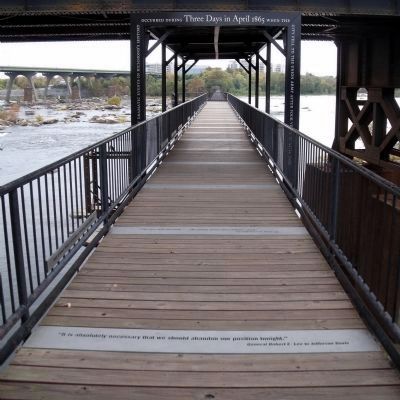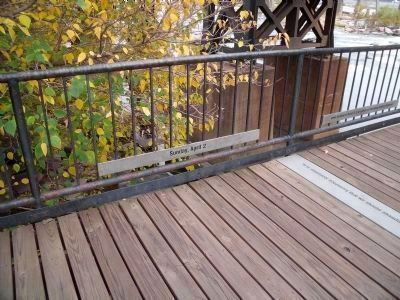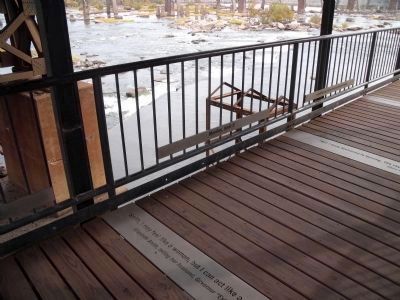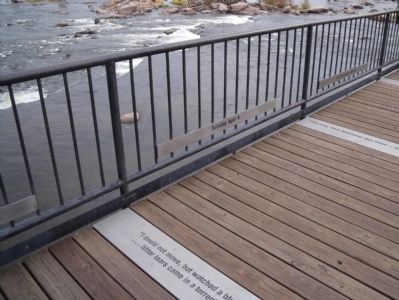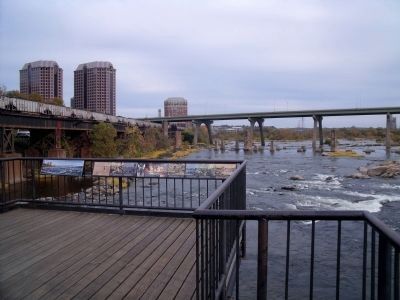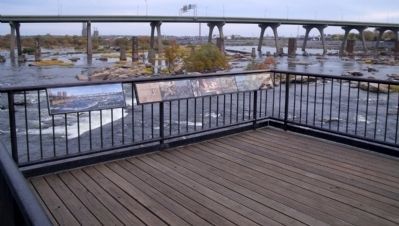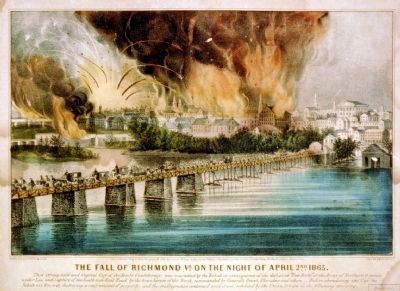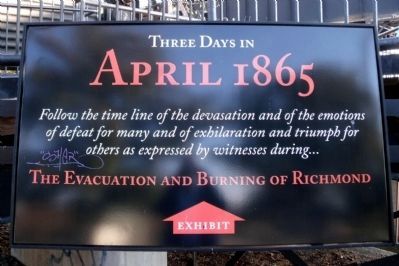Gambles Hill in Richmond, Virginia — The American South (Mid-Atlantic)
Three Days in April 1865
Topics. This historical marker is listed in this topic list: War, US Civil. A significant historical month for this entry is April 1865.
Location. 37° 32.05′ N, 77° 26.659′ W. Marker is in Richmond, Virginia. It is in Gambles Hill. Marker can be reached from Tredegar Street near South 5th Street. This series of markers are incorporated into the James River overlook on the north west corner of Brown's Island. Touch for map. Marker is in this post office area: Richmond VA 23219, United States of America. Touch for directions.
Other nearby markers. At least 8 other markers are within walking distance of this marker. Belle Isle (a few steps from this marker); Potterfield Bridge (a few steps from this marker); Haxall Headgates (within shouting distance of this marker); Tredegar Iron Works (about 300 feet away, measured in a direct line); Canal Walk / Historic Canals (about 300 feet away); Joseph Reid Anderson (about 400 feet away); a different marker also named Tredegar Iron Works (about 400 feet away); The Falls of the James (about 400 feet away). Touch for a list and map of all markers in Richmond.
Also see . . .
1. Fall of Richmond. Civil War Richmond (Submitted on October 28, 2009.)
2. Abraham Lincoln's Visit to Richmond . Civil War Richmond (Submitted on October 28, 2009.)
3. Reaction to the Fall of Richmond. American Battlefield Trust (Submitted on November 9, 2009.)
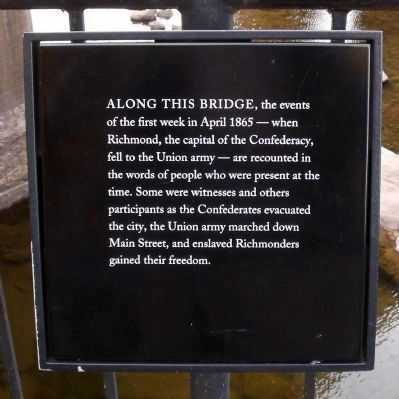
Photographed By Bernard Fisher, October 25, 2009
2. Three Days in April 1865 Exhibit
Along this bridge, the events of the first week in April 1865—when Richmond, the capital of the Confederacy, fell to the Union army—are recounted in the words of people who were present at the time. Some were witnesses and others participants as the Confederates evacuated the city, the Union army marched down Main Street, and enslaved Richmonders gained their freedom.
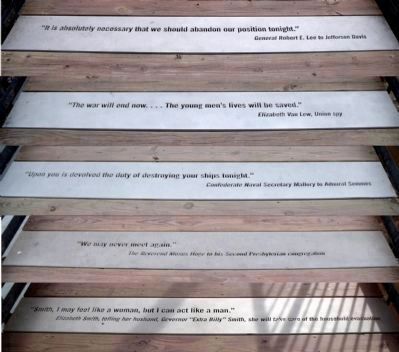
Photographed By Bernard Fisher, October 25, 2009
6. Sunday, April 2 Quotations
“It is absolutely necessary that we should abandon our position tonight.” General Robert E. Lee to Jefferson Davis
“The war will end now….The young men’s lives will be saved.” Elizabeth Van Lew, Union spy
“Upon you is devolved the duty of destroying your ships tonight.” Confederate Naval Secretary Mallory to Admiral Semmes
“We may never meet again.” The Reverend Moses Hoge to his Second Presbyterian congregation
“Smith, I may feel like a woman, but I can act like a man.” Elizabeth Smith, telling her husband, Governor “Extra Billy” Smith, she will take care of the household evacuation
“The war will end now….The young men’s lives will be saved.” Elizabeth Van Lew, Union spy
“Upon you is devolved the duty of destroying your ships tonight.” Confederate Naval Secretary Mallory to Admiral Semmes
“We may never meet again.” The Reverend Moses Hoge to his Second Presbyterian congregation
“Smith, I may feel like a woman, but I can act like a man.” Elizabeth Smith, telling her husband, Governor “Extra Billy” Smith, she will take care of the household evacuation
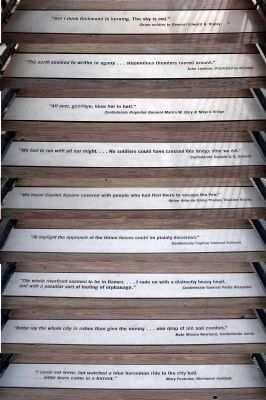
Photographed By Bernard Fisher, October 25, 2009
8. Monday, April 3 Quotations
“Sir! I think Richmond is burning. The sky is red.” Union soldier to General Edward H. Ripley
“The earth seemed to writhe in agony…stupendous thunders roared around.” John Leyburn, Presbyterian minister
“All over, goodbye; blow her to hell.” Confederate Brigadier General Martin W. Gary at Mayo’s Bridge
“We had to run with all our might….No soldiers could have crossed this bridge after we did.” Confederate Captain D. B. Sanford
“We found Capitol Square covered with people who had fled there to escape the fire.” Union Aide-de-Camp Thomas Thatcher Graves
“At daylight the approach of the Union forces could be plainly discerned.” Confederate Captain Clement Sulivane
“The whole riverfront seemed to be in flames….I rode on with a distinctly heavy heart and with a peculiar sort of feeling of orphanage.” Confederate General Porter Alexander
“Better lay the whole city in ashes than give the enemy…one drop of aid and comfort.” Kate Mason Rawland, Confederate nurse
“I could not move, but watched a blue horseman ride to the city hall…bitter tears came in a torrent.” Mary Fontaine, Richmond resident
“The earth seemed to writhe in agony…stupendous thunders roared around.” John Leyburn, Presbyterian minister
“All over, goodbye; blow her to hell.” Confederate Brigadier General Martin W. Gary at Mayo’s Bridge
“We had to run with all our might….No soldiers could have crossed this bridge after we did.” Confederate Captain D. B. Sanford
“We found Capitol Square covered with people who had fled there to escape the fire.” Union Aide-de-Camp Thomas Thatcher Graves
“At daylight the approach of the Union forces could be plainly discerned.” Confederate Captain Clement Sulivane
“The whole riverfront seemed to be in flames….I rode on with a distinctly heavy heart and with a peculiar sort of feeling of orphanage.” Confederate General Porter Alexander
“Better lay the whole city in ashes than give the enemy…one drop of aid and comfort.” Kate Mason Rawland, Confederate nurse
“I could not move, but watched a blue horseman ride to the city hall…bitter tears came in a torrent.” Mary Fontaine, Richmond resident
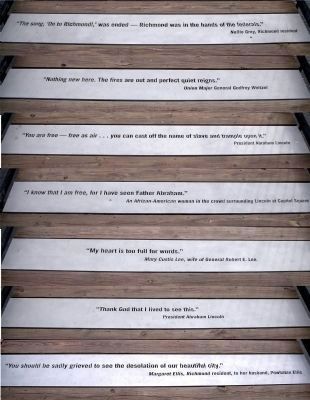
Photographed By Bernard Fisher, October 25, 2009
10. Tuesday, April 4 Quotations
“The song, ‘On to Richmond!,’ was ended —— Richmond was in the hands of the Federals.” Nellie Grey, Richmond resident
“Nothing new here. The fires are out and perfect quiet reigns.” Union Major General Godfrey Weitzel
“You are free—free as air…you can cast off the name of slave and trample upon it.” President Abraham Lincoln
“I know that I am free, for I have seen Father Abraham.” An African-American woman in the crowd surrounding Lincoln at Capitol Square
“My heart is too full for words.” Mary Custis Lee, wife of General Robert E. Lee
“Thank God that I lived to see this.” President Abraham Lincoln
“You should be sadly grieved to see the desolation of our beautiful city.” Margaret Ellis, Richmond resident, to her husband, Powhatan Ellis
“Nothing new here. The fires are out and perfect quiet reigns.” Union Major General Godfrey Weitzel
“You are free—free as air…you can cast off the name of slave and trample upon it.” President Abraham Lincoln
“I know that I am free, for I have seen Father Abraham.” An African-American woman in the crowd surrounding Lincoln at Capitol Square
“My heart is too full for words.” Mary Custis Lee, wife of General Robert E. Lee
“Thank God that I lived to see this.” President Abraham Lincoln
“You should be sadly grieved to see the desolation of our beautiful city.” Margaret Ellis, Richmond resident, to her husband, Powhatan Ellis
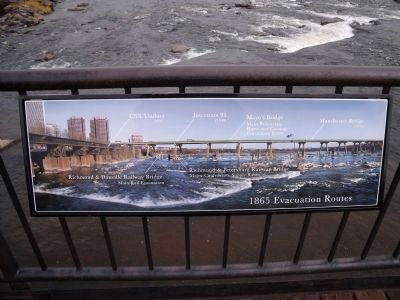
Photographed By Bernard Fisher, October 25, 2009
13. 1865 Evacuation Routes
left to right
CSX Viaduct (1901)
Richmond & Danville Railway Bridge
Main Rail Evacuation
Interstate 96 (1958)
Richmond & Petersburg Railway Bridge
Major Confederate Supply Route
Mayo’s Bridge
Main Pedestrian, Horse and Carriage Evacuation Route
Manchester Bridge (1972)
CSX Viaduct (1901)
Richmond & Danville Railway Bridge
Main Rail Evacuation
Interstate 96 (1958)
Richmond & Petersburg Railway Bridge
Major Confederate Supply Route
Mayo’s Bridge
Main Pedestrian, Horse and Carriage Evacuation Route
Manchester Bridge (1972)
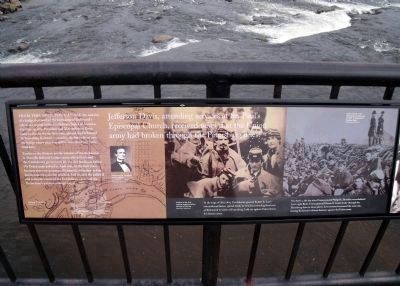
Photographed By Bernard Fisher, October 25, 2009
14. Fall of Richmond (left panel)
From this spot, you can see the remains of a bridge that marked the beginning of Richmond’s role as the capital of the Confederate States of America. On May 29, 1861, President and Mrs. Jefferson Davis came to the city for the first time, aboard the Richmond & Petersburg Railroad — crossing the James River over the bridge whose piers can still be seen about 200 yards from here.
Farther in the distance are the remains of the Richmond & Danville Railroad bridge, across which Davis and the Confederate government left the city just hours before the Union army arrived in April 1865. In the four years between these two journeys, Richmond, a city that at first had hesitated to join the rebellion, had become the political and economic center of the Confederate cause and the Union army’s primary strategic target.
Jefferson Davis, attending services at St. Paul’s Episcopal Church, received news that the Union army had broken through the Petersburg lines.
In the siege of 1864-1865, Confederate general Robert E. Lee’s outnumbered forces, spread thinly in trenches extending from east of Richmond to south of Petersburg, held out against Union forces for almost a year.
On April 2, the day after Union general Philip H. Sheridan overwhelmed Lee’s right flank, Union general Ulysses S. Grant broke through the Petersburg lines in three places. Lee retreated westward the same day, leaving Richmond without defenses against the Union army.
On the top left is a portrait of “Jefferson Davis, President of the Southern Confederacy, c. 1850.” Valentine Museum
The left background consist of an “1856 map of Richmond” highlighting the Richmond & Petersburg Railroad Bridge, Richmond & Danville Railroad Bridge, and Mayo’s Bridge. Valentine Museum
In the center is a photo of the “Soldiers of the First Virginia Regiment before the start of the war.” Valentine Museum
On the right is a photo of “Union infantry in the Petersburg trenches early in 1865. Photograph by Mathew Brady.” Valentine Museum
Farther in the distance are the remains of the Richmond & Danville Railroad bridge, across which Davis and the Confederate government left the city just hours before the Union army arrived in April 1865. In the four years between these two journeys, Richmond, a city that at first had hesitated to join the rebellion, had become the political and economic center of the Confederate cause and the Union army’s primary strategic target.
Jefferson Davis, attending services at St. Paul’s Episcopal Church, received news that the Union army had broken through the Petersburg lines.
In the siege of 1864-1865, Confederate general Robert E. Lee’s outnumbered forces, spread thinly in trenches extending from east of Richmond to south of Petersburg, held out against Union forces for almost a year.
On April 2, the day after Union general Philip H. Sheridan overwhelmed Lee’s right flank, Union general Ulysses S. Grant broke through the Petersburg lines in three places. Lee retreated westward the same day, leaving Richmond without defenses against the Union army.
On the top left is a portrait of “Jefferson Davis, President of the Southern Confederacy, c. 1850.” Valentine Museum
The left background consist of an “1856 map of Richmond” highlighting the Richmond & Petersburg Railroad Bridge, Richmond & Danville Railroad Bridge, and Mayo’s Bridge. Valentine Museum
In the center is a photo of the “Soldiers of the First Virginia Regiment before the start of the war.” Valentine Museum
On the right is a photo of “Union infantry in the Petersburg trenches early in 1865. Photograph by Mathew Brady.” Valentine Museum
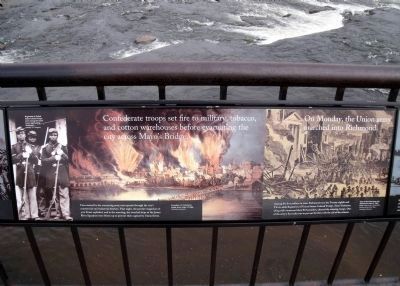
Photographed By Bernard Fisher, October 25, 2009
15. Fall of Richmond (center panel)
Confederate troops set fire to military, tobacco, and cotton warehouses before evacuating the city across Mayo’s Bridge.
Fires started by the evacuating army soon spread through the city’s commercial and industrial districts. That night, the powder magazine on 47th Street exploded, and in the morning, the ironclad ships of the James River Squadron were blown up to prevent their capture by Union forces.
On Monday, the Union army marched into Richmond.
Among the first soldiers to enter Richmond were the Twenty-eighth and Thirty-sixth Regiments of United States Colored Troops. Some Unionists, along with numerous black Richmonders, cheered the entering troops. One of the army’s first tasks was to put out the fires with the aid of the citizens.
On the left is a photo with the caption, “Regiments of United States Colored Troops were among the Union forces approaching Richmond.” Library of Congress
In the center is a painting of the “Evacuation of Confederate troops across Mayo’s Bridge.” Valentine Museum
On the right is a sketch depicting the “Entry of the Union army into Richmond on April 3, 1865. From Frank Leslie’s Illustrated History of the Civil War.” Valentine Museum
Fires started by the evacuating army soon spread through the city’s commercial and industrial districts. That night, the powder magazine on 47th Street exploded, and in the morning, the ironclad ships of the James River Squadron were blown up to prevent their capture by Union forces.
On Monday, the Union army marched into Richmond.
Among the first soldiers to enter Richmond were the Twenty-eighth and Thirty-sixth Regiments of United States Colored Troops. Some Unionists, along with numerous black Richmonders, cheered the entering troops. One of the army’s first tasks was to put out the fires with the aid of the citizens.
On the left is a photo with the caption, “Regiments of United States Colored Troops were among the Union forces approaching Richmond.” Library of Congress
In the center is a painting of the “Evacuation of Confederate troops across Mayo’s Bridge.” Valentine Museum
On the right is a sketch depicting the “Entry of the Union army into Richmond on April 3, 1865. From Frank Leslie’s Illustrated History of the Civil War.” Valentine Museum
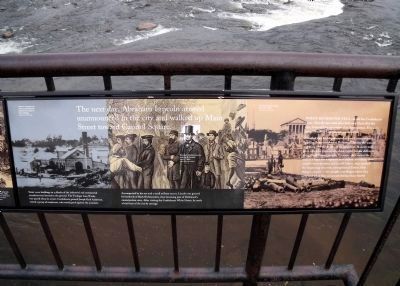
Photographed By Bernard Fisher, October 25, 2009
16. Fall of Richmond (right panel)
The next day, Abraham Lincoln arrived unannounced in the city and walked up Main Street toward Capitol Square.
Some 1,000 buildings in 15 blocks of the industrial and commercial riverfront were burned to the ground. The Tredegar Iron Works was spared when its owner, Confederate general Joseph Reid Anderson, armed a group of employees, who stood guard against the arsonists.
Accompanied by his son and a small military escort, Lincoln was greeted by hundreds of black Richmonders, thus becoming part of Richmond’s emancipation story. After visiting the Confederate White House, he made a brief tour of the city by carriage.
When Richmond fell, so did the Confederate cause. Exactly one week after Jefferson Davis fled the city, General Lee surrendered at Appomattox. Five days later, President Lincoln was assassinated.
No other city had experienced so much concentrated fighting in its environs as Richmond during the war, or anything like the drama of its final days. In a city with such a diverse population, these events meant different things to different people. To some, they meant the end of a hope for a separate new nation; to others, they meant emancipation; and still others, they marked the beginning of a new, strengthened Union. One thing is certain — few people ever forgot where they were and what they witnessed during those fateful days of April 1865.
On the left is a “View of Tredegar Iron Works, showing how near the fire came to the buildings.” National Archives
In the center is an illustration of “President Abraham Lincoln entering Richmond, April 4, 1865.” Valentine Museum
On the right is a photo of “A Federal soldier among the ruins, 1865.” Valentine Museum
Some 1,000 buildings in 15 blocks of the industrial and commercial riverfront were burned to the ground. The Tredegar Iron Works was spared when its owner, Confederate general Joseph Reid Anderson, armed a group of employees, who stood guard against the arsonists.
Accompanied by his son and a small military escort, Lincoln was greeted by hundreds of black Richmonders, thus becoming part of Richmond’s emancipation story. After visiting the Confederate White House, he made a brief tour of the city by carriage.
When Richmond fell, so did the Confederate cause. Exactly one week after Jefferson Davis fled the city, General Lee surrendered at Appomattox. Five days later, President Lincoln was assassinated.
No other city had experienced so much concentrated fighting in its environs as Richmond during the war, or anything like the drama of its final days. In a city with such a diverse population, these events meant different things to different people. To some, they meant the end of a hope for a separate new nation; to others, they meant emancipation; and still others, they marked the beginning of a new, strengthened Union. One thing is certain — few people ever forgot where they were and what they witnessed during those fateful days of April 1865.
On the left is a “View of Tredegar Iron Works, showing how near the fire came to the buildings.” National Archives
In the center is an illustration of “President Abraham Lincoln entering Richmond, April 4, 1865.” Valentine Museum
On the right is a photo of “A Federal soldier among the ruins, 1865.” Valentine Museum
Credits. This page was last revised on February 1, 2023. It was originally submitted on October 28, 2009, by Bernard Fisher of Richmond, Virginia. This page has been viewed 3,818 times since then and 65 times this year. Photos: 1, 2, 3, 4, 5, 6, 7, 8, 9, 10, 11, 12, 13, 14, 15, 16. submitted on October 28, 2009, by Bernard Fisher of Richmond, Virginia. 17. submitted on November 2, 2009, by Bernard Fisher of Richmond, Virginia. 18. submitted on November 4, 2009, by Bernard Fisher of Richmond, Virginia. 19. submitted on October 28, 2009, by Bernard Fisher of Richmond, Virginia.
